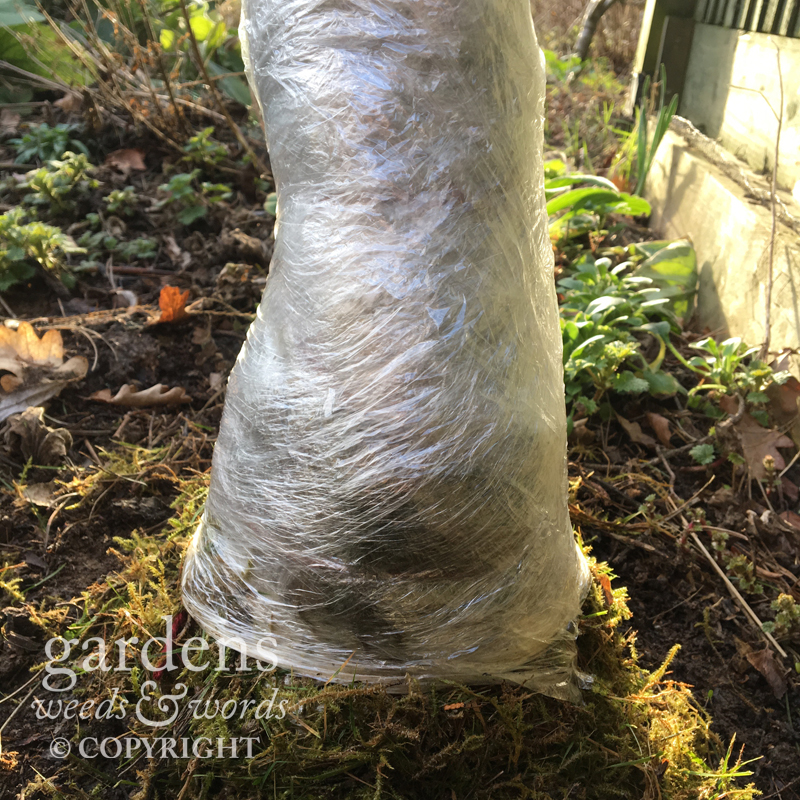We thought we’d got past the rabbit damage problem. Well, if not quite got rid of the critters themselves, at least managed to reach a workable compromise with the furry little demons – they’d hop about, munch the odd plant they could get to easily, we’d fence off anything too young or fragile with an infrastructure that wouldn’t tax a really determined rabbit, but would make anything behind it less appealing by comparison to other, more easily reached fodder. It was working quite well, until I glanced over at the fig tree.
Now the fig tree isn’t the usual rabbit delicacy. Rabbits will, as we’ve learned to our cost, eat anything, even plants on the supposedly Rabbit Proof Plant Lists, of which there are many (you can read about our efforts to keep the pests away from a new planting in this particular garden here) – but so far, they’d not gone for anything woody. And when it comes to woody, it’s usually young tree saplings you think of protecting – hence all those ghastly plastic spiral guards you see on newly planted trees in any large landscaping project; a sensible precaution (though beware in very sunny positions they can bake a delicate young tree into oblivion). But rabbits, I’ve now learned, will go for older trees in winter when food is scarce (or even when it isn’t, it hasn’t exactly been a harsh winter in the south east of the UK), and this fig is at least five years old.
I first noticed a white patch at the base of the trunk, which I thought was paint, and couldn’t work out how it had got there. I certainly didn’t remember painting anything there myself. A closer examination revealed the horrid truth – a concerted effort had been made upon the tree, almost completely ringing it by removing the bark around the entire circumference of the stem. This is far from a good thing – the living tissue of the tree is found in the top few layers of the bark, the hardened wood in the centre being there simply for support. Without the vascular tissue of the cambium to conduct the water upwards from the roots, or the nutrients manufactured in the leaves and stem downwards towards the subterranean parts, there’s a pretty serious interruption in the ability of the plant to function, and ultimately, survive.
Shining out like a white band on a belisher beacon, the rabbit damage was clearly visible across the garden
In the case of our fig, there are two, not particularly confidence-inspiring, areas of un-nibbled bark which maintain the continuity, albeit with seriously reduced efficiency.
Thin bands of continuous bark on both the left and right of the trunk bridge the wound caused by the rabbit damage
If the tree is to have a chance of survival, the priority was to protect the damaged area, to keep it moist, and create conditions in which the cells of the remaining bark and cambium layer can grow and multiply. I packed moist moss around the wound, bound the lot in clingfilm, and finished off with a winding of waterproof duct tape to keep the bandage in place. A more attractive and eco-friendly version would have seen hessian substituted for the plastic film, but I had none to hand.
Using moss around the wound caused by the rabbit damage to create an environment in which we hope the bark will begin to heal
This I’m hoping, will hold for the while. I’m considering removing a fair portion of the top growth of the fig – as it seems logical that, although there’s a sufficient root system to support the current canopy, the passageway between the roots and the upper portions of the plant is now a significant bottleneck, and I wonder if a hard prune now, before the sap begins to rise, will reduce the stress on the tissue as it repairs itself.
A further step would be to provide more bridges between areas above and below the wound, which could be done by grafting in strips of live wood cut and prepared from the branches – not something I’ve done before, but it seems a sensible course of action, if I can get it to work. Some research to be done – I’ll start here.
And in the meantime, the chicken wire cages have come out again, this time around the triaged fig, but also on the fruit tree fans along the same fence, just in case the rabbits decide to have a go at those.
Clingfilm wrapped around the moss to keep it in place and hold moisture in.
I’d love to hear if you have experienced rabbit damage in your garden, or whether your plants have become a favourite snack for squirrels, deer, or anything else for that matter – and what you’ve done to combat their attentions. Let me know on twitter, or in the comments below.





